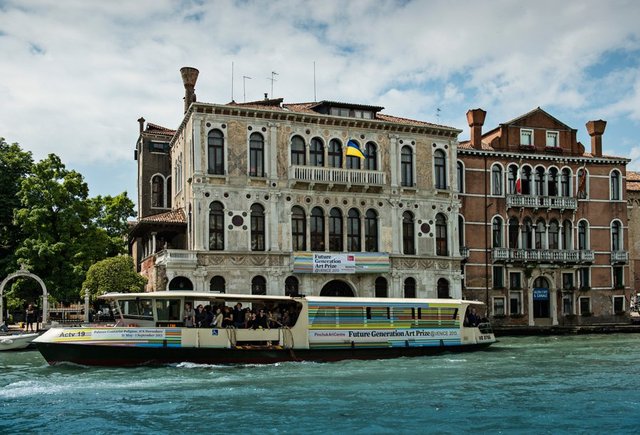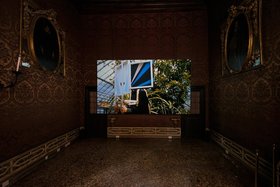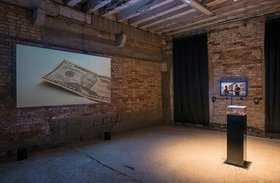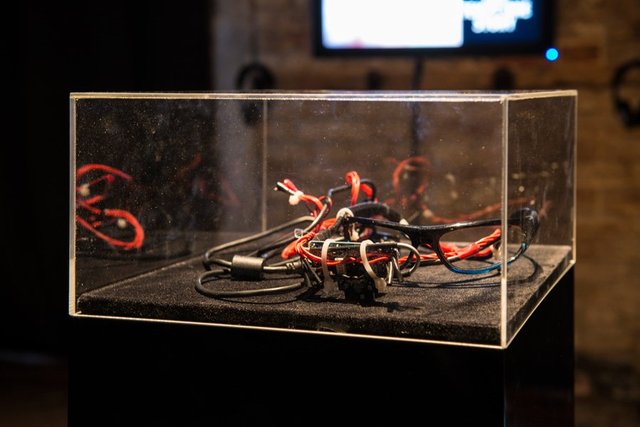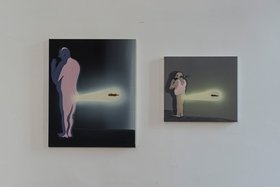Reviews
Future Generation Art Prize 2013
Palazzo Contarini Polignac, Venice
The PinchukArtCentre's Future Generation Art Prize is an international accolade initiated by the Victor Pinchuk Foundation in 2009, and seeks to identify, discover and support a future generation of artists, up to the age of 35. The second edition, which took place in 2012, awarded the Main Prize to British artist Lynette Yiadom-Boakye, with Special Prizes handed to Jonathas de Andrade (Brazil), Marwa Arsanios (Lebanon), Ahmet Öğüt (Turkey) and Rayyane Tabet (Lebanon).
Future Generation Art Prize @Venice 2013 (1st June – 1st September 2013) shows the work of all 21 shortlisted (for 2013) and Future Generation Art Prize-winning artists. Awarded at the end of 2012, the 21 artists included span 16 countries, with almost of a quarter of them hailing from the MENASA region (and neighbouring countries). Tapping into the international significance of the Venice Biennale, the PinchukArtCentre presented, for the first time, new commissions and existing works in an off-site, collateral space: the grand Palazzo Contarini Polignac. It is an odd and anachronistic setting for works of contemporary art. But as one grows accustomed to this practice at the Venice Biennale, flourishes of classical architecture, wallpapers featuring cherubs and saints, and gold plated fireplaces as backdrops for works, many of which were made with a white cube in mind, become the norm. Although not a curated exhibition, but more of a considered showcase, the Future Generation Art Prize@Venice 2013 constituted a plethora of individual voices, that one necessarily viewed as distinct, divergent and dissonant. With this in mind, a number of specific artworks resonated particularly within the exhibition, with an agency that was quite surprising given the established reputations and profiles of all the shortlisted artists.
Egyptian artist Basim Magdy (b.1977) works across mediums that include painting, drawing, photography and the moving image. Future Generation… presented Time Laughs Back at You Like a Sunken Ship, 2012 a 9.5 minutes long ode to memory and time, fact and fiction, and how they lapse and dissolve into one another. Shot on Super8 film and transferred to HD video it captures - in the depth and grain typical of the medium - images that speak of history, forgetting and the im/permanence of the physical world around us. Scenes include an ancient Roman ruin in Alexandria, a ship floating on an indistinguishable horizon and a man wearing a strange, futuristic mirror appendage as he ambles through a stately garden. Described by the artist as 'A film about waiting, time, ageing, boredom and that huge shadow called nothingness', these seemingly disparate images are brought together by a haunting soundtrack, and poetic title that hints at Magdy's propensity for the absurd, humorous and always sublimely beautiful. The film is elliptical in its portrayal of nostalgia and time that has passed, further emphasised by the inherent qualities of Super8 film. Markers obfuscate the act of pinning the film to any specific time and space, but instead suggests, with eloquence, simultaneously the present, recent past and unknown future.
In Eyewriter/DIY/Arbakir: Chapter Two, 2012-13, Turkish artist Ahmet Öğüt (b. 1981) presents a similarly prosthetically-enhanced vision of the future to that of Magdy, but with completely divergent means and ends. Eyewriter is a piece of technology developed in the US to allow paralysed and disabled individuals to draw using only their eyes. With support the developers hope to make it available for free via open source software and networks. In his installation, Öğüt presents a prototype of the device and two videos. In the first, he describes the Eyewriter product and those responsible for its conception. In the second we see him writing the URL of the Eyewriter website (laboriously) on single dollar bills (his Future Generation Art Prize money) and distributing these at five different Turkish weddings. The pumping soundtrack of the wedding party accentuates the installation's upbeat and hopeful approach; groups of men, young and old, dance in synchronised steps and Öğüt throws money at men's dancing feet and at the newlyweds. It is an absurdist and performative gesture of generosity at Turkish weddings. Somehow, the artist has transported the viewer from suburban America to rural Turkey, via sci-fi sunglasses. The work is unique in the exhibition, in terms of the unusual position the artist takes in relation to the work, its social implications and how it lays bare the mechanism of the artist prize, the flow of money, and how a gesture can become an act and position of activism.
Iranian artist Tala Madani's (b.1981) hand-painted single-screen stop-motion animations are delightfully playful and morbidly and scatologically grotesque. Projected on a tiny screen on the wall of the grand palace (Venice location) ten or more short films (of a few seconds up to a minute) present a catalogue of observations and weird/twisted fantasies on a loop. All men, mostly on their own, the figures dance, self-mutilate and attack, accompanied by titles such as Music Man, Hospital, Head bug, Metro, Apple Tree, Chit Chat, Under Man, Taxi, Dancer. Each gesture, expression and movement is captured with a messy elegance by the artist's paintbrush. Madani's work curiously straddles fields and expectations; animation reminds the viewer instantly of cartoons and Disney films, but here the content would be more aligned with the absurb, toilet humour of South Park, Beavis and Butthead and Ren and Stimpy. And yet, her films are textured in a way that animated films are not. She celebrates and exaggerates the brushstrokes, the presence of which adds a sense of haste, deliberation, and an inkling of the sheer number of individual images necessary to make one short sequence. The willingness to demonstrate this aspect of laboriousness to the viewer in contrast to the slickness of cartoons that deny the process of animating, in favour of a whimsical, magic perception, is what makes her work so alluring. That and the roster of horrors acted out on her male protagonists. These helpless figures are Madani's targets of revenge and humiliation, as representatives of the canon; male, white characters that have and remain so dominant in art history. The accompanying large-scale paintings run with this theme, with a particular focus on the abject and scatological. In Rare Projection (Modern Shit) (2013), a dumpy white male nude is depicted with a levitating turd. Madani's work is strategically subversive and aggressive. With humour, and an unflinching sensibility she gets to the heart of taboo, the male gaze and the overwhelming presence of the male in art, (especially painting) and the history that surrounds it.
Within the regionalising setting of the Venice Biennale's national pavilions, and further, the 'artist profile' format appropriated by the Future Generation Art Prize@Venice 2013, geography and nationality is a category that came to organise the artists in this exhibition further. Nonetheless, in and of themselves, the works I have highlighted here, produced in but not necessarily about the MENASA region, presented broader narratives of history, contemporaneity, technology and access to it, all executed with great skill and intent. Eschewing broader curatorial frameworks and devices, and skirting the territory of the national pavilion structure – although still viewed within this paradigm – Future Generation Art Prize@Venice 2013 acted as an opportunity to encounter specific artists, with an impetus on the viewer to locate them within the exhibition, and more broadly within the artist's individual practices.

